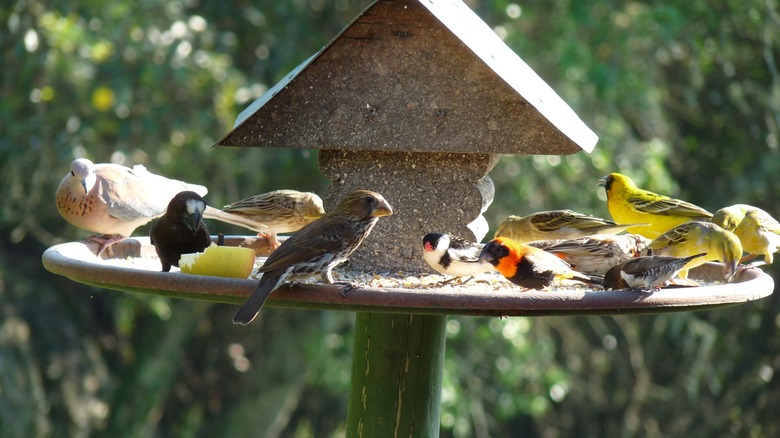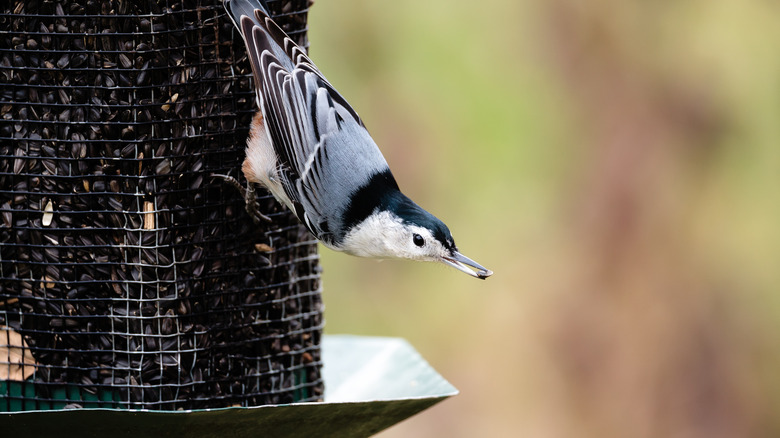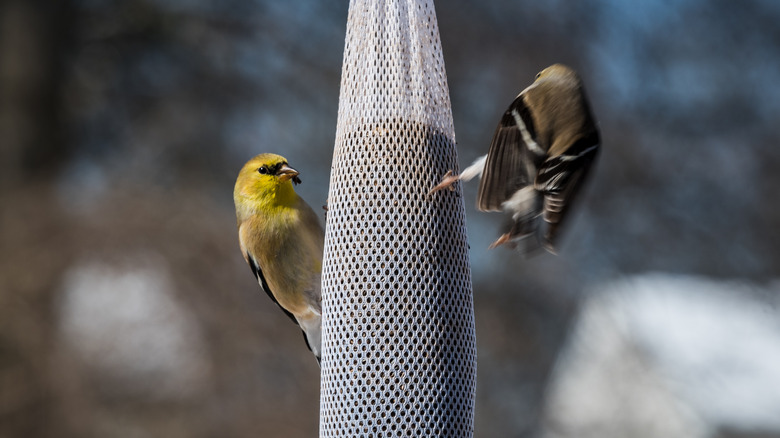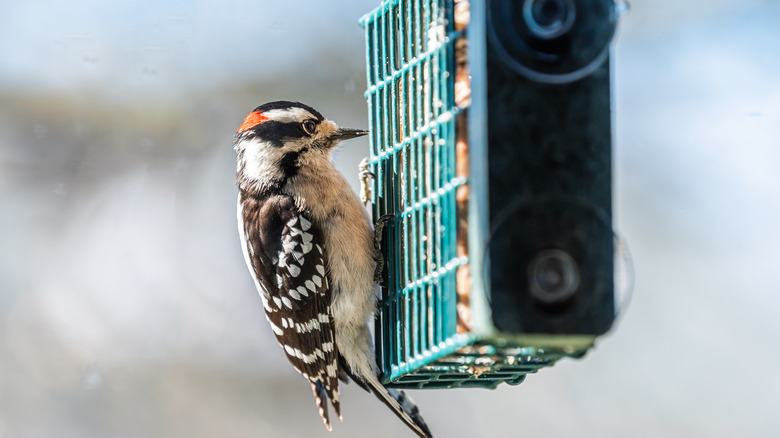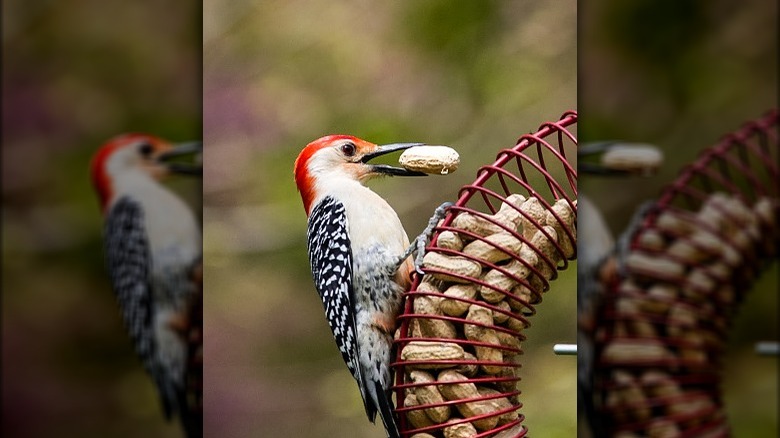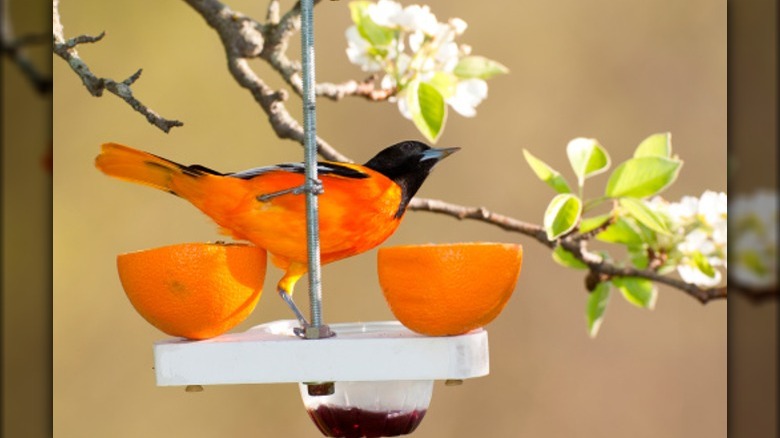5 Types Of Bird Seed And Which Ones To Use To Attract Your Favorites
We may receive a commission on purchases made from links.
One day, you're young and hip, the next, you're thinking, "Oh my gosh! A yellow warbler!" This is when you know you are officially a grown-up. Seriously, though, birds are amazing, and backyard birding is a wonderful way to relax and spend quality time with nature. If you want to attract certain kinds of birds to your feeder, you need to offer the right kinds of food. (Oh, and don't worry, we know you are still young and hip!)
When you are shopping for birdseed, the options are kind of overwhelming. Why are there two different kinds of sunflower seeds? What is a suet cake? Who eats these bits of corn? With over 800 species of birds in the United States, it is not surprising that each has its own favorite food. To attract a wide variety of birds, consider adding a few different types of feeders and food options.
Sunflower seeds
Sunflower seeds come in striped and black oil options. Birds typically favor black oil sunflower seeds because their thin shell is easier to open, even for smaller species. Cardinals, finches, the tufted titmouse, and chickadees are just some of the many common birds that will happily flock to your feeder to feast on them. If you are lucky, you might see woodpeckers or an evening grosbeak at your feeder.
The challenge with sunflower seeds is that birds are not the only ones who love these little nuts. If you live in an area with a lot of squirrels, you may find yourself frustrated with those furry fiends. Investing in a squirrel-proof feeder is one way to keep them from eating all your bird seed. If you like to use tray feeders, which are preferred by doves and grosbeaks, consider switching to safflower seeds, which are similar to sunflowers but disliked by squirrels.
Thistle
Thistles growing in wild fields are a favorite among American goldfinches and indigo buntings. These two types of tiny, beautiful birds are a treat to watch if you can lure them to your backyard feeders. Thistle seed, also known as Nyjer, is a tiny seed that contains a lot of oil. While these feathered friends eat thistle seed in the wild, what you buy at the store is a little different. If you have ever encountered a thistle plant, you know how unpleasant they are – certainly not something you want sprouting up in your yard! Commercially available thistle seed is imported from overseas and must be heat treated so they cannot sprout.
To provide thistle seed for your backyard birds, you will need a special feeder. Since these seeds are so small, a standard bird feeder cannot contain them. Thistle socks are inexpensive and convenient. There are also different styles of feeders specifically designed to hold tiny seeds for tiny birds.
Suet cakes
Suet cakes combine seeds, nuts, and sometimes other nutrient-dense ingredients with fat to attract a variety of birds. Some people leave suet cakes out year-round, while others just provide extra fuel for migrating and overwintering birds in the cooler seasons. Since suet cakes can be pretty expensive, how long you use them really depends on how much you want to spend yearly on attracting birds. This feeding option attracts a wide variety of species, from big red-bellied woodpeckers to tiny nuthatches. You just never know what you will see at your feeder. Unfortunately, like sunflower seeds, suet cakes are a favorite of squirrels. Thankfully, manufacturers have found a solution to this problem: spicy suet cakes. The heat does not repel birds, but squirrels do not like it.
Suet cake feeders come in many styles, from super simple and cheap, to more aesthetically pleasing and pricy. You can even purchase a multi-purpose feeder if you have limited space. The concept for all suet cake feeders is the same — they are essentially a cage that holds the square cake while providing a place for birds to perch while they eat.
Peanuts
Have you ever found an empty peanut shell in your yard and wondered where it came from? Maybe one of your neighbors is offering peanuts to attract birds. These shelled nuts are a favorite of large birds like bluejays and woodpeckers, as well as smaller ones like chickadees. Part of the fun of feeding peanuts is watching the birds work their way through the shell for the meaty nuts within. You might want to skip this feeding option if you have a lot of wild visitors coming to your yard — and we don't mean raucous family members. Peanuts are also coveted by raccoons, squirrels, and even bears!
There are only two types of feeders for this food option, hanging peanut holders and trays. One challenge with feeding peanuts is that they rot quickly after it rains, so you will need to just put out a handful of nuts each day or place your feeder in a covered area.
Fruit
If you find yourself with extra fruit in the house, consider feeding it to the birds. You may be surprised to know that common birds like cardinals, sparrows, and blackbirds love a sweet treat. You can also attract more exotic birds to your backyard, including some warblers and tanagers. Orioles are known for their love of oranges, and there are special feeders specifically designed for their favorite meal of oranges with grape jelly.
You can use a basic tray feeder to share small fruits like strawberries, blueberries, and raisins with your feathered friends. For solid fruits like oranges and apples, a simple nail in the side of the tree is a good hanging spot that is easy to access. Suet cake feeders also make good fruit holders. You can also just toss the fruit on the ground for birds that prefer to forage. Grapes, bananas, and cherries are all excellent choices to attract beautiful birds to your backyard.
